Comments / Questions (21)
![]() Sylvie wrote:
Sylvie wrote:
Bonjour. Pour la taille S il est noté au tout début des explications : continuer jusqu'à ce que l'ouvrage mesure 14 cm. Faut il mesurer a partir des mailles montées entre les 2 épaules ou du début des épaules ? Merci pour votre aide
26.09.2024 - 20:20DROPS Design answered:
Bonjour Sylvie, mesurez à partir des mailles montées pour l'une des épaules, pas à partir de l'encolure dos. Bon tricot!
27.09.2024 - 08:47
![]() Sylvie wrote:
Sylvie wrote:
Bonjour Si j'ai bien vu il n'y a pas as de diagrammes A6A et A6B dans la taille M ? Merci pour votre réponse
23.09.2024 - 21:05DROPS Design answered:
Bonjour Sylvie, tout à fait, on ne tricote pas A.6 en taille M. Bon tricot!
24.09.2024 - 09:13
![]() Angelika Romanski wrote:
Angelika Romanski wrote:
Hallo, soll die linke und rechte Schulter jeweils getrennt gestrickt werden ... soviel Rundstricknadeln in den vorgegebenen Größe habe ich nicht. In der Anleitung steht nicht, ob die Maschen dann stillgelegt werden sollen .... für die Passe auch wieder neu anschlagen oder wie? HG Angelika
20.08.2022 - 00:26DROPS Design answered:
Liebe Angelika, ja die beiden Schulter beim Rückenteil werden separat gestrickt, dh die linke Schulter zuerst stricken und zur Seite legen, dann die rechte Schulter stricken. Danach stricken Sie die rechte Schulter, schlagen Sie neue Maschen für den Halsausschnitt und stricken Sie die linke Schulter. Sie können die Maschen auf einen Faden stilllegen (siehe Video), so brauchen Sie keine zusätzliche Rundnadel. Viel Spaß beim stricken!
22.08.2022 - 09:20
![]() Elfa wrote:
Elfa wrote:
Góðan dag, er að velta fyrir mér hvort það passar eða hvort það er prentvilla að handvegsútaukning hefst eftir færri cm á stóru númerunum en þeim minni, eins og handvegurinn verði víðari á minni númerunum?
03.07.2021 - 11:21DROPS Design answered:
Blessuð Elfa. Ermin er styttri í heildina í stærri stærðum. Þar sem breiddin á líkamanum / öxlinni er stærri í stærri stærðum þannig að þá verður ermin styttri í stærri stærðunum en í þeim minni.
18.08.2021 - 11:45
![]() Dorthe Sørby wrote:
Dorthe Sørby wrote:
Hej DROPS jeg er ved at strikke modellen 188-24. str. xxxl jeg er kommet til side 5 .hvor der står at arbejdet måler 16 cm. og kan simpelthen ikke forstå det næste. jeg har nu 291 m på pinden . jeg skal dernæst få 459 m. men forstår ikke hvordan jeg får taget ud (hvilket mønster jeg skal bruge, til at få de 459 m.) jeg forstår heller ikke hvilket mønster jeg skal bruge EFTER jeg har fået 459 m. på en str. xxxl venlig hilsen Dorthe
25.08.2020 - 13:32DROPS Design answered:
Hej Dorthe, jo når arbejdet måler 16 cm følger du og tager ud ifølge diagram A.7a (i din størrelse). På 7.pind tager du 2m ud (1 i hver side af diagrammet) for hver gang du strikker A.7a i bredden. God fornøjelse!
27.08.2020 - 15:42
![]() Cornelia wrote:
Cornelia wrote:
Na de eerste meerdering kom ik er niet uit hoe ik verder moet
20.09.2019 - 16:13DROPS Design answered:
Dag Cornelia,
Bedoel je de meerderingen voor de armsgaten op de pas aan de achterkant? Je meerdert daar 4-4-6-6-11-11 in totaal aan beide kanten, aan de goede kant van het werk en deze steken brei je in tricotsteek.
23.09.2019 - 09:46
![]() Schuitemaker Cornelia wrote:
Schuitemaker Cornelia wrote:
Hoe moet ik verder na de eerste meerdering
20.09.2019 - 16:12
![]() Helle Petersen wrote:
Helle Petersen wrote:
Er der en fejl i diagram forklaring. Kan ikke forstå at der er 2 der er ens
24.05.2019 - 12:40DROPS Design answered:
Hei Helle. Ja, symbol nummer 2 (x) skal strikkes vrang fra rettsiden, rett fra vrangen. Vi skal få rettet dette i oppskriften. Takk for beskjed og god fornøyelse
24.05.2019 - 13:17
![]() Øygunn Leite Kallevik wrote:
Øygunn Leite Kallevik wrote:
Hei! Jeg prøver å få starte på denne, men klarer ikke å få det til å passe. På bakstykket: skal jeg fortsette på A2 fra der jeg har kommet før jeg la opp til hals?
08.02.2019 - 18:52DROPS Design answered:
Hei Øygunn. Ja, du strikker som før over maskene på skulderen, fortsett med A.2 (på samme omgang som der du nå er) over maskene på bakstykket, og strikker som før over maskene på den andre skulderen. God fornøyelse
13.02.2019 - 11:44
![]() Jose wrote:
Jose wrote:
Wat wordt er bedoeld met "als het kledingstuk gedragen wordt"?
08.12.2018 - 12:19DROPS Design answered:
Dag Jose,
Hiermee wordt bedoeld dat als je het kledingstuk draagt, dat dan de knoopsgaten in de rechter voorbies moeten zitten. Dit geldt eveneens voor de rechter- en linkerschouder, dus gezien zoals het kledingstruk gedragen wordt.
09.12.2018 - 16:38
Lydia#lydiacardigan |
||||||||||||||||||||||||||||
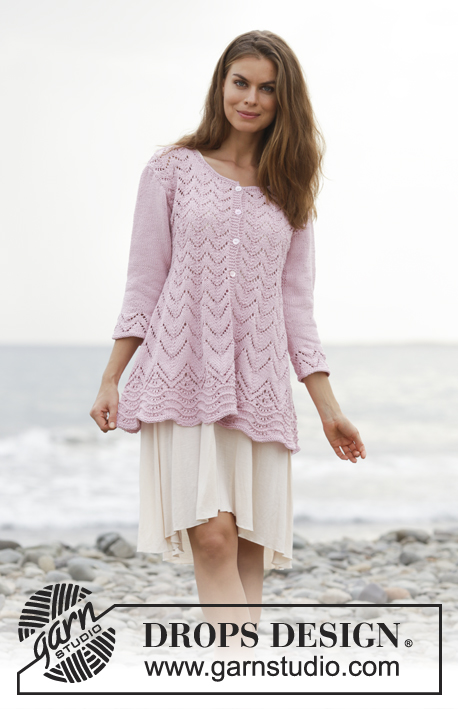 |
 |
|||||||||||||||||||||||||||
Jacket with lace pattern and wave pattern, knitted top down. Size: S - XXXL Piece is knitted in DROPS Muskat.
DROPS 188-24 |
||||||||||||||||||||||||||||
|
INFORMATION FOR PATTERN: GARTER STITCH (back and forth): 1 ridge = knit 2 rows. GARTER STITCH (in the round - applies to sleeves): 1 ridge = 2 rounds. Knit 1 round and purl 1 round. INCREASE TIP (applies to yoke): All increases are done from the right side. Increase by making 1 yarn over inside 1 edge stitch in garter stitch. Purl yarn over twisted on next row, it should not make holes. DECREASE TIP (applies to body and sleeves): Decrease 1 stitch on each side of marker thread as follows: Work until 3 stitches remain before marker thread and knit 2 together, knit 2 (marker thread is between these stitches), slip next stitch knitwise, knit 1, pass slipped stitch over stitch worked (= 2 stitches decreased in total). PATTERN: See diagrams A.1 to A.8. Choose diagram for your size in A.5 to A.8. Diagrams show all rows in pattern seen from the right side. BUTTONHOLES: Decrease for buttonholes on right band (when garment is worn). Decrease from right side when 4 stitches remain on row as follows: Make 1 yarn over, knit the next 2 stitches together, knit the last 2 stitches. On next row knit yarn over to make holes. Decrease first buttonhole when band on right front piece measures approx. 1½-2 cm. Then decrease the next 7 buttonholes, approx. 7-7-7-7-7½-7½ cm between each. ---------------------------------------------------------- JACKET: Worked back and forth on circular needle, top down. First work each shoulder separately before slipping piece together. First work the sleeves back and forth on circular needle and then in the round on double pointed needles, top down. BACK PIECE: First work 2 shoulder, cast on stitches for neck, slip shoulders together and then work back and forth down to armhole. LEFT SHOULDER (when garment is worn): Cast on 17-22-21-26-25-30 stitches (including 1 edge stitch) on circular needle size 3.5 mm with Muskat. Knit 1 row from wrong side and knit 1 row from right side. Switch to circular needle size 4 mm. Work from wrong side. Purl until 1 stitch remains, finish with 1 edge stitch in GARTER STITCH - see explanation above (= towards armhole). Work next row as follows from right side: Work 1 edge stitch in garter stitch, A.1 over next stitch, work A.2 (= 10 stitches) over the next 10-20-10-20-20-20 stitches (= 1-2-1-2-2-2 times in width), finish with 5-0-9-4-3-8 stitches in stocking stitch (= towards neck). Continue pattern like this. REMEMBER THE KNITTING TENSION! When piece measures 2 cm, put piece aside and work right shoulder (adjust so that last row is worked from right side). RIGHT SHOULDER (when garment is worn): Cast on 17-22-21-26-25-30 stitches (including 1 edge stitch) on circular needle size 3.5 mm with Muskat. Knit 1 row from wrong side and knit 1 row from right side. Switch to circular needle size 4 mm. Work as follows from WS: Work 1 edge stitch in garter stitch (= towards armhole), purl the rest of row. Work next row as follows from right side (= from the neck): Work 6-1-10-5-4-9 stitches in stocking stitch, work A.2 over the next 10-20-10-20-20-20 stitches (= 1-2-1-2-2-2 times in width) and finish with 1 edge stitch in garter stitch. Continue pattern like this. When piece measures 2 cm, adjust measurement with left shoulder, same number of rows should now have been worked as on left shoulder (i.e. last row is worked from right side), cast on stitches for neck between right shoulder and left shoulder from wrong side as follows: Work right shoulder as follows: 1 edge stitch in garter stitch, pattern as before over remaining stitches, cast on 39-39-41-41-43-43 new stitches, work pattern as before over left shoulder until 1 stitch remains and finish with 1 edge stitch in garter stitch. YOKE AT THE BACK: = 73-83-83-93-93-103 stitches. Work next row as follows from right side: Work 1 edge stitch in garter stitch, A.1 over next stitch as before, work A.2 over the next 70-80-80-90-90-100 stitches (= 7-8-8-9-9-10 times in width), finish with 1 edge stitch in garter stitch. Continue pattern like this until piece measures 14-15-15-16-13-14 cm. Now increase 1 stitch – read INCREASE TIP - for armhole inside 1 edge stitch in garter stitch in each side of piece on every row from right side (= 2 stitches increased). Increase like this 4-4-6-6-11-11 times in total = 81-91-95-105-115-125 stitches. Work the increased stitches in stocking stitch. Cast on 5-4-6-6-8-9 stitches at the end of next row from wrong side and 6-5-7-7-9-10 stitches at the end of next row from right side = 92-100-108-118-132-144 stitches. Work the increased stitches in stocking stitch. Work 1 row from wrong side. Piece now measures approx. 18-19-20-21-22-23 cm. Put piece aside and work the front pieces. RIGHT FRONT PIECE: Cast on 17-22-21-26-25-30 stitches (including 1 edge stitch) on circular needle size 3.5 mm with Muskat. Knit 1 row from wrong side and knit 1 row from right side. Switch to circular needle size 4 mm. Work from wrong side. Purl until 1 stitch remains, finish with 1 edge stitch in garter stitch. Work next row as follows from right side (= from the armhole): Work 1 edge stitch in garter stitch, A.1 over next stitch, work A.2 over the next 10-20-10-20-20-20 stitches (= 1-2-1-2-2-2 times in width), finish with 5-0-9-4-3-8 stitches in stocking stitch. When piece measures 4-4-5-5-6-6 cm, cast on new stitches for neck at the end of every row from right side as follows: Cast on 1 stitch 4 times, 2 stitches 3 times and 15-15-16-16-17-17 stitches 1 time = 42-47-47-52-52-57 stitches. Work the increased stitches in stocking stitch. Then work next row from right side as follows: Work 1 edge stitch in garter stitch, A.1 over next stitch, A.2 over the next 30-40-40-40-40-50 stitches, A.3 (= 5 stitches) over the next 5-0-0-5-5-0 stitches and finish with 5 band stitches in garter stitch. Decrease for BUTTONHOLES - see explanation above. When piece measures 15-16-16-17-14-15 cm (adjust measurement with back piece and make sure that next row is from right side, 8-8-12-12-22-22 rows now remain until piece is put together) increase 1 stitch for armhole inside 1 edge stitch in garter stitch at the beginning of every row from right side. Increase like this 4-4-6-6-11-11 times in total = 46-51-53-58-63-68 stitches. Then cast on 5-4-6-6-8-9 stitches at the end of next row from wrong side = 51-55-59-64-71-77 stitches. Piece now measures approx. 18-19-20-21-22-23 cm. Put piece aside and work the left front piece. LEFT FRONT PIECE: Cast on 17-22-21-26-25-30 stitches (including 1 edge stitch) on circular needle size 3.5 mm with Muskat. Knit 1 row from wrong side and knit 1 row from right side. Switch to circular needle size 4 mm. Work from wrong side. Work 1 edge stitch in garter stitch (= towards armhole), purl the rest of row. Work next row as follows from right side (= from the neck): Work 6-1-10-5-4-9 stitches in stocking stitch, work A.2 over the next 10-20-10-20-20-20 stitches (= 1-2-1-2-2-2 times in width) and finish with 1 edge stitch in garter stitch. Continue pattern like this. When piece measures 4-4-5-5-6-6 cm, cast on new stitches for neck at the end of every row from wrong side as follows: Cast on 1 stitch 4 times, 2 stitches 3 times and 15-15-16-16-17-17 stitches 1 time = 42-47-47-52-52-57 stitches. Work the increased stitches in stocking stitch. Then work next row from right side as follows: Work 5 band stitches in garter stitch, A.1 over 0-1-1-0-0-1 stitch, A.4 (= 6 stitches) over the next 6-0-0-6-6-0 stitches, work A.2 over the next 30-40-40-40-40-50 stitches (= 3-4-4-4-4-5 times in width), finish with 1 edge stitch in garter stitch. When piece measures 14-15-15-16-13-14 cm (adjust measurement with back piece and make sure that next row is from right side, 10-10-14-14-24-24 rows now remain until piece is put together) increase 1 stitch for armhole inside 1 edge stitch in garter stitch at the end of every row from right side. Increase like this 4-4-6-6-11-11 times in total = 46-51-53-58-63-68 stitches. Then cast on 6-5-7-7-9-10 stitches at the end of next row from right side = 52-56-60-65-72-78 stitches. Work the increased stitches in stocking stitch. Work 1 row from wrong side. Piece now measures approx. 18-19-20-21-22-23 cm. BODY: Now work all parts together from right side as follows: First work over left front piece as follows: Work 5 band stitches in garter stitch, A.1 over 0-1-1-0-0-1 stitch, A.4 over the next 6-0-0-6-6-0 stitches, work A.2 over the next 30-40-40-40-40-50 stitches, 11-10-14-14-21-22 stitches in stocking stitch, insert 1 marker thread. Then work over back piece as follows: Work 10-9-13-13-20-21 stitches in stocking stitch, A.1 over next stitch, work A.2 over the next 70-80-80-90-90-100 stitches as before (= 7-8-8-9-9-10 times in width), 11-10-14-14-21-22 stitches in stocking stitch. Then work over right front piece as follows: Insert 1 marker thread, work 10-9-13-13-20-21 stitches in stocking stitch, A.1 over next stitch, work A.2 over the next 30-40-40-40-40-50 stitches, A.3 over the next 5-0-0-5-5-0 stitches and finish with 5 band stitches in garter stitch. Continue pattern like this. There are now 195-211-227-247-275-299 stitches on row and there are 21-19-27-27-41-43 stitches in stocking stitch in total between front pieces and back piece. Insert 1 marker in the piece. NOW MEASURE PIECE FROM HERE! When piece measures 2 cm, decrease 1 stitch on each side of both marker threads (= 4 stitches decreased) - read DECREASE TIP. Decrease like this every 2-2-3-3-2-9 cm 6-5-4-4-6-2 times in total = 171-191-211-231-251-291 stitches. When all stitches have been decreased, 9-9-19-19-29-39 stitches in stocking stitch remain between front pieces and back piece. When piece measures 11-12-13-14-15-16 cm from marker, adjust to finish with a whole repetition of A.2, then work as follows from right side: Work 5 band stitches in garter stitch, A.5a (= 1 stitch) over the next 0-1-1-0-0-1 stitch, A.6a over the next 6-0-0-6-6-0 stitches, work A.7a over the next 150-180-200-210-230-280 stitches (= 15-18-20-21-23-28 repetitions in width), A.8a (= 5 stitches) over the next 5-0-0-5-5-0 stitches and finish with 5 band stitches in garter stitch. Continue pattern like this. Increase stitches in A.6a to A.8a. When A.5a to A.8a have been worked 1 time vertically, there are 267-299-331-363-395-459 stitches on needle. Work A.5b over A.5a, A.6b over A.6a, A.7b over A.7a and A.8b over A.8a. When all stitches in A.6b to A.8b have been increased, there are 347-353-371-407-443-459 stitches on row. When 4 rows remain in A.5b to A.8b, switch to circular needle size 3.5 mm. On last row in A.5b to A.8b cast off as follows: Cast off 5 band stitches by knitting, cast off A.5b to A.8b as shown in diagrams, cast off the last 5 band stitches, make sure to avoid a tight cast-off edge, cast off with needle 1 size larger if needed. Piece measures approx. 62-64-66-68-70-72 cm in total. SLEEVE: Worked top down. Work sleeve cap back and forth on circular needle, then work sleeve in the round on double pointed needles until finished measurements. Cast on 23-25-27-31-33-37 stitches on circular needle size 4 mm with Muskat. Work stocking stitch back and forth and cast on new stitches for sleeve cap at the end of every row in each side as follows: Cast on 3 stitches 1-1-2-5-4-3 times, 2 stitches 7-8-6-1-1-0 times, 1 stitch 4-3-5-7-9-14 times and 2-2-3-3-5-7 stitches 1 time = 69-73-79-85-89-97 stitches (piece measures approx. 9-9-10-10-11-13 cm). When sleeve cap has been worked, switch to double pointed needles size 4 mm. Insert 1 marker thread at beginning of round (= mid under sleeve) and continue in stocking stitch in the round. When piece measures 12-12-13-13-14-16 cm, decrease 2 stitches mid under sleeve. Decrease like this every 3-2-1½-1½-1½-1 cm 9-11-14-12-14-18 times in total = 51-51-51-61-61-61 stitches. When piece measures 37-35-36-35-36-35 cm, work A.2 over all stitches AT THE SAME TIME on first round decrease 1 stitch (i.e. work A.2 5-5-5-6-6-6 times in total in width) = 50-50-50-60-60-60 stitches. When A.2 has been worked 2 times vertically, switch to double pointed needles size 3.5 mm and work 2 ridges in GARTER STITCH – see explanation above. Then cast off, make sure to avoid a tight cast-off edge, cast off with 1 larger needle size if needed. Piece measures approx. 44-42-43-42-43-42 cm. Work the other sleeve the same way. ASSEMBLY: Sew the shoulder seams. Sew in sleeves inside 1 edge stitch. Sew the buttons on to left front piece. NECK EDGE: Pick up 100-124 stitches around the neck on circular needle size 3.5 mm. Work 2 ridges back and forth. Then cast off, make sure to avoid a tight cast-off edge, cast off with 1 larger needle size if needed. |
||||||||||||||||||||||||||||
Diagram explanations |
||||||||||||||||||||||||||||
|
||||||||||||||||||||||||||||

|
||||||||||||||||||||||||||||

|
||||||||||||||||||||||||||||

|
||||||||||||||||||||||||||||
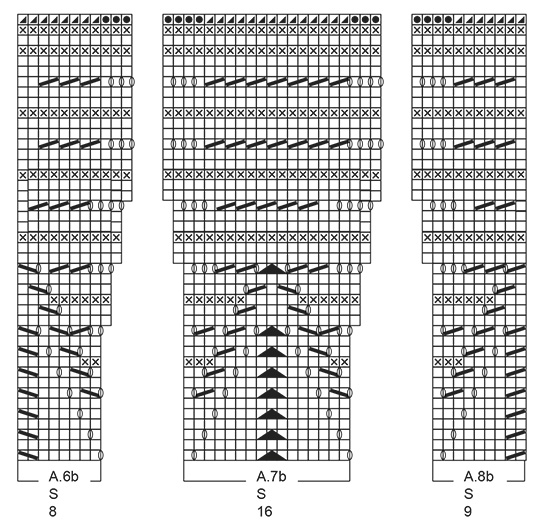
|
||||||||||||||||||||||||||||

|
||||||||||||||||||||||||||||
Have you finished this pattern?Tag your pictures with #dropspattern #lydiacardigan or submit them to the #dropsfan gallery. Do you need help with this pattern?You'll find 33 tutorial videos, a Comments/Questions area and more by visiting the pattern on garnstudio.com. © 1982-2025 DROPS Design A/S. We reserve all rights. This document, including all its sub-sections, has copyrights. Read more about what you can do with our patterns at the bottom of each pattern on our site. |
||||||||||||||||||||||||||||







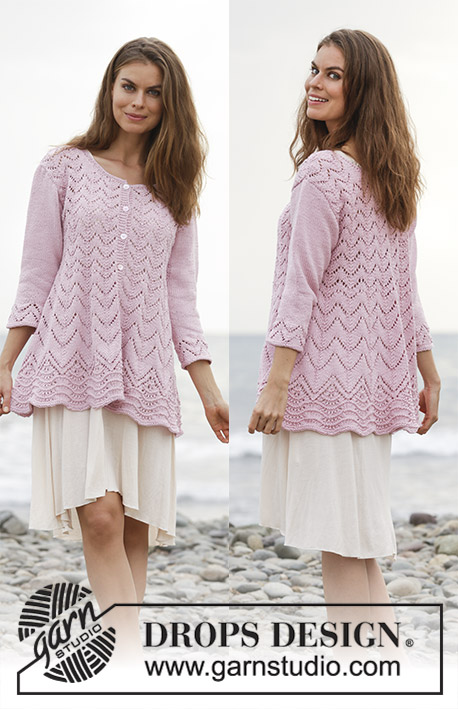











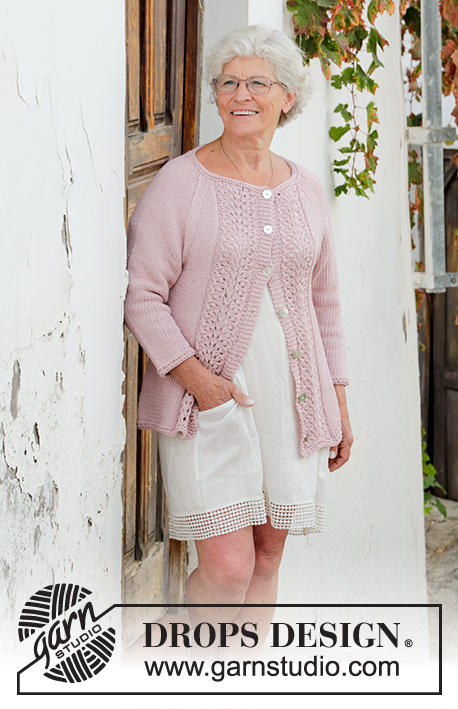
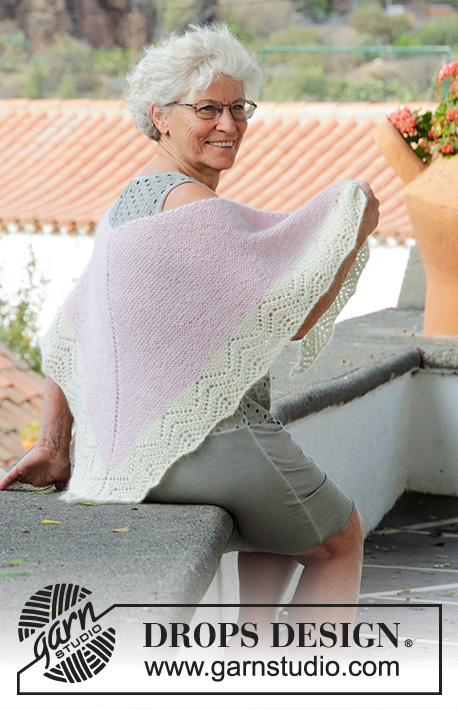





























































Post a comment to pattern DROPS 188-24
We would love to hear what you have to say about this pattern!
If you want to leave a question, please make sure you select the correct category in the form below, to speed up the answering process. Required fields are marked *.